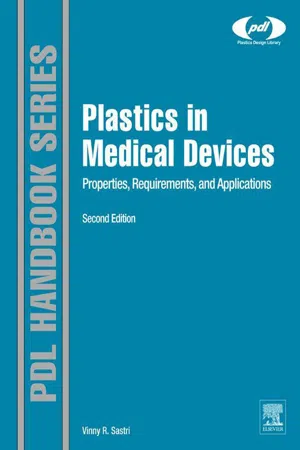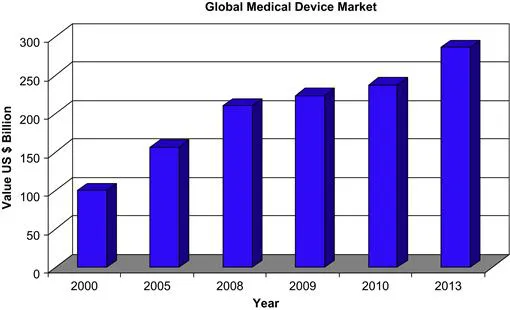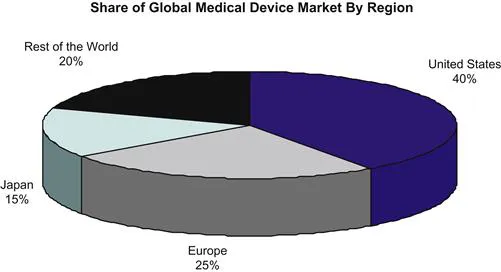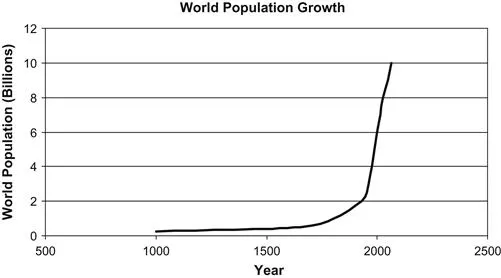1.1 Introduction
The global medical device industry is estimated to be between US $220 and $250×109 in value. This industry continues to show a healthy growth rate, overcoming many economic downturns or slowdowns. It is projected to grow from about US $100 billion to almost US $300×109 in 2015. Figure 1.1 shows the growth from 2000 projected to 2013. These numbers are aggregates from various reports and sources. Numbers of the actual market size vary from report to report. The United States has about 40% of the global market share, followed by Europe, Japan, and the rest of the world (Figure 1.2). Germany is the largest market in Europe, followed by France, Italy, and the United Kingdom. Japan is the second-largest country by market share, after the United States.
Figure 1.1 Global medical device market.
Figure 1.2 Global medical device market share by region.
The rest of the world comprises regions like China, India, and Latin America. These regions are seeing 10–15% annual growth rates in the medical device market. One of the reasons for this growth is the population increase in these regions compared to the United States and Europe. The Population Reference Bureau projects that the world will have close to 10,000,000,000 people by the year 2050, as shown in Figure 1.3. Most of this growth will come from regions like China, India, Latin America, and Africa. As a result, the demand for health care and medical devices continues to increase for these regions and globally as well.
Figure 1.3 World population growth.
Several factors affect the growth of the medical device market. They include the following:
1.1.1 Population Growth and Aging Populations
In addition to the population growth statistics mentioned above, populations are aging in countries like the United States, nations in Western Europe, and Japan. The number of people over the age of 65 will increase dramatically over the next 10–20 years. This demographic will require more healthcare diagnostics and surgical procedures, like cardiovascular and orthopedic operations. Affordable health care is becoming more accessible to large numbers of people in regions like China and India as the economies of these countries continue to grow. This, coupled with their large populations, will increase the need for medical devices and diagnostics.
1.1.2 Minimally Invasive Procedures
Shorter hospital stays and the increase in the use of minimally invasive surgeries require innovative, effective disposable devices. These devices are using more electronics, are getting smaller, and require demanding performance during procedures. Biocompatibility and electrical and thermal management will be very important for these devices.
1.1.3 Increase of Infectious Diseases
With the increase and spread of infectious diseases globally, many prophylactic devices and therapies are required. New drug therapies need to be administered using lipids, which can be aggressive on standard plastics during drug delivery. Materials that do not react, degrade, swell, crack, or leach out impurities when in contact with lipids need to be used.
1.1.4 Outpatient and Home Health Care
Home health care and outpatient care require either healthcare providers or individuals to use certain types of devices by themselves. Such devices must be safe, effective, easy to use, and ergonomically well designed. Remote diagnostics also will increase, leading to the need for computerized diagnostic devices that can analyze and send data to doctors and physicians hundreds of thousands of miles away for evaluation and diagnosis.
Research and development in new drugs, biomaterials, biomedical engineering, new procedures, and the increased use of electronics will lead to sophisticated medical devices like sensing devices, ultra-high-resolution imaging systems, combination products (drug-device hybrids), nanodevices, biorobotics, microfluidic devices, molecular diagnostics, and orthopedic implants.
1.2 Medical Device Definition
Medical devices range from simple devices like tongue depressors, syringes, and bandages to highly sophisticated imaging machines and long-term surgical implants. Examples of medical devices include surgical instruments, catheters, coronary stents, pacemakers, magnetic resonance imaging (MRI) machines, X-ray machines, prosthetic limbs, artificial hips and knees, surgical gloves, and bandages.
Medical devices are regulated by the Food and Drug Administration (FDA) in the United States. A medical device, as defined by the US FDA, is anything used for therapeutic and/or diagnostic purposes in humans or animals, which is not a drug. The definition of “medical device” is given in Section 201 of the Food Drug and Cosmetic (FD&C) Act [1]. As per this act, “a medical device is an instrument, apparatus, implement, machine, contrivance, implant in vitro reagent, or other similar related article, including any component, part or accessory which is:
1. Recognized in the official National Formulary, or the United States Pharmacopeia, or any supplement to them,
2. Intended for use in the diagnosis of disease or other conditions, or in the cure, mitigation, treatment, or prevention of disease, in man or other animals, or
3. Intended to affect the structure or any function of the body of man or other animals, and which does not achieve its primary intended purpose through chemical action within or on the body of man or other animals and which is not dependent upon being metabolized for the achievement of its primary intended purposes.”
In the European Medical Device Directive [2], a medical device is defined as a product with a medical intended purpose, whether for diagnosis, treatment, or alleviation of a medical condition in humans, and is not a drug. As per this directive, “a medical device is defined as any instrument, apparatus, appliance, software, material or other article. This includes if this device is used alone or in combination with software necessary for its proper application intended by the manufacturer to be used for human beings in the purpose of:
1. Diagnosis, prevention, monitoring, treatment, or alleviation of disease
2. Diagnosis, monitoring, treatment, alleviation of, or compensation for an injury or handicap
3. Investigation, replacement, or modification of the anatomy or of a physiological process control of conception and which does achieve its principal intended action by pharmacological process, immunological, or metabolic means, but may be assisted in its function by such means.”
Devices are classified into three classes: Class I, Class II, and Class III [3], depending upon their risk and criticality. Each device class requires a different level of regulation and compliance. Examples of Class I devices are tongue depressors, bandages, gloves, bedpans, and simple surgical devices. Examples of Class II devices are wheelchairs, X-ray machines, MRI machines, surgical needles, catheters, and diagnostic equipment. Class III devices are used inside the body. Most implants are Class III devices. Examples include heart valves, stents, implanted pacemakers, silicone implants, and hip and bone implants. The Medical Device Directive (MDD) [2] classifies devices as Class I, Class II, Class IIa, and Class III in order of increasing risk.
1.3 Types of Devices
Medical devices can be classified into two major categories—disposables and nondisposables. Examples of nondisposable devices include machines and instruments, diagnostic equipment, surgical and dental instruments, prostheses, and implants. Examples of disposable devices include bandages, gloves, blood bags, colostomy bags, catheters, syringes, IV kits, and tubing.
Materials used in nondisposable applications typically must meet long-term durability and stringent physical and mechanical properties. Materials used in machines and diagnostic equipment do not necessarily need to be sterilized or meet specific chemical resistance or biocompatibility requirements. Examples of diagnostic and surgical equipment are MRI machines, electrocautery devices, and electrocardiogram (ECG) monitors. Implants, on the other hand, must meet strict biocompatibility, biodurability, and sterilization requirements to be safe and effective in the body. Active implant devices include pacemakers, artificial cochlear devices to help restore hearing, and implantable neurostimulators used to control pain or incontinence. Nonactive implantable devices include coronary stents for treating vascular disease and knee and hip replacement devices.
Materials used in nondisposable applications must meet processing, assembly, physical, and mechanical requirements specific to the application and intended use. In addition, they may need to have chemical and/or lipid resistance, be resistant to specific sterilization methods, and also may need to be biocompatible and nontoxic. Material and production costs are also important to consider.
There is a wide spectrum of requirements that apply to materials used in medical device applications. It is important to understand these requirements and design the right part with the right material that fits the intended use and the processing and assembly of the finished device.



